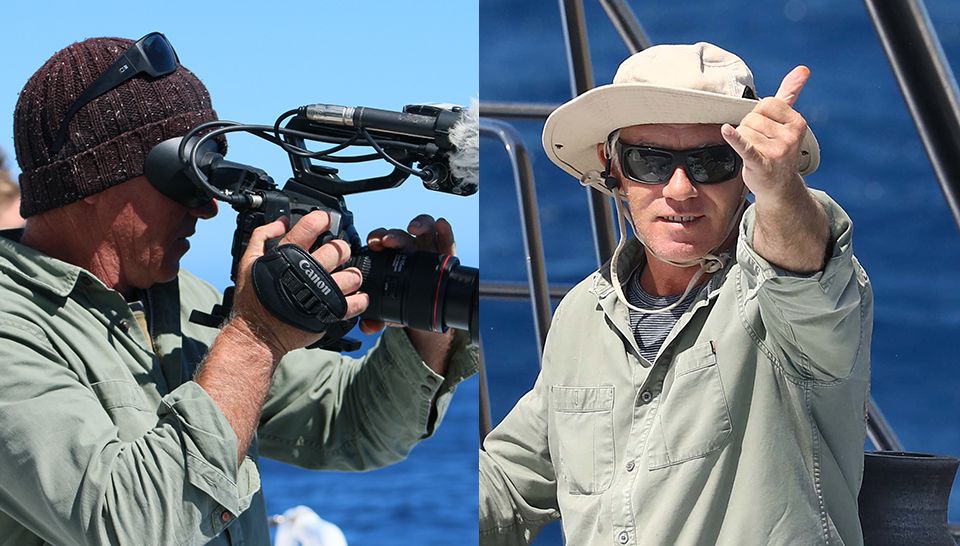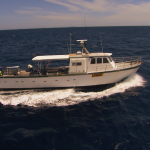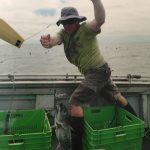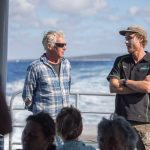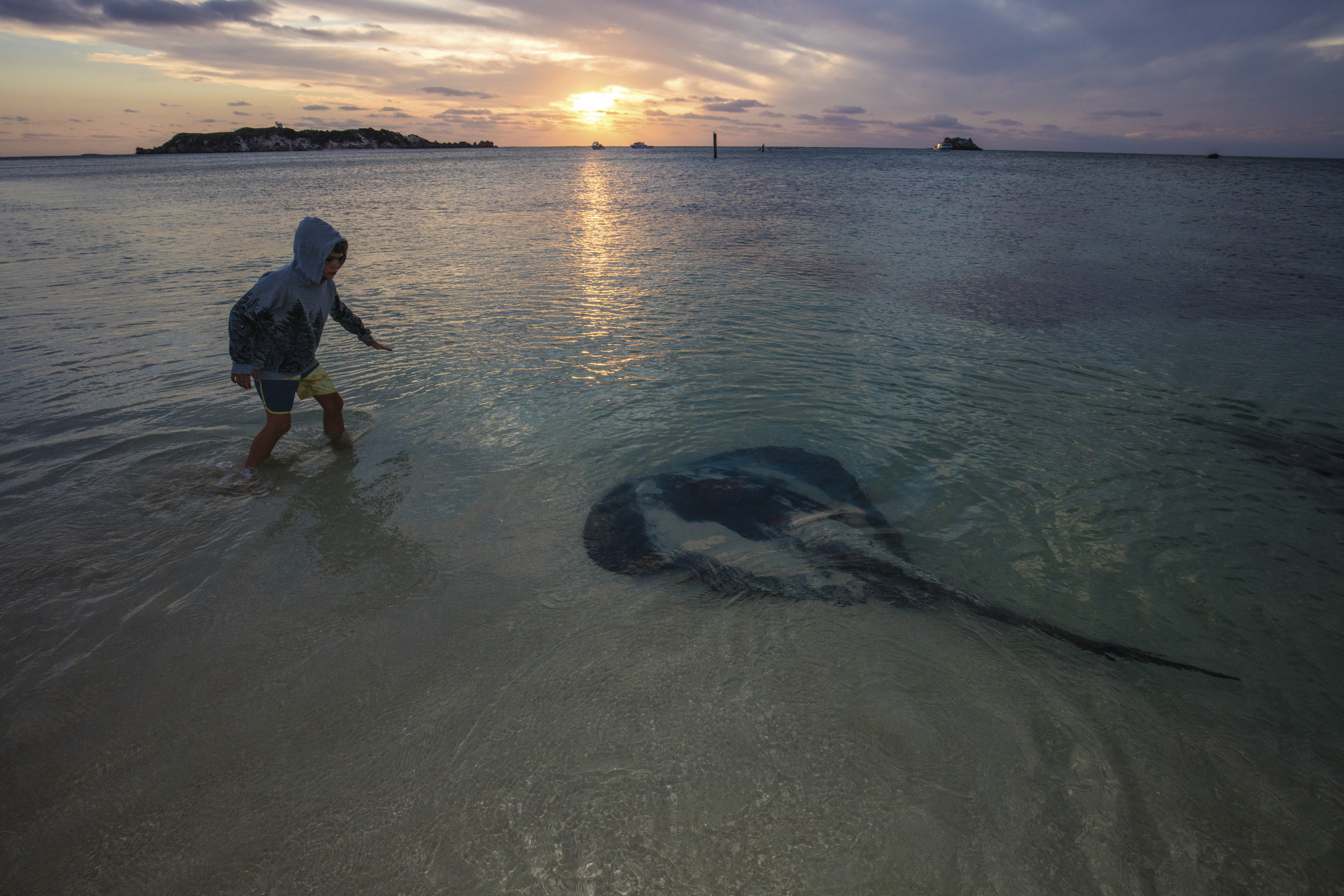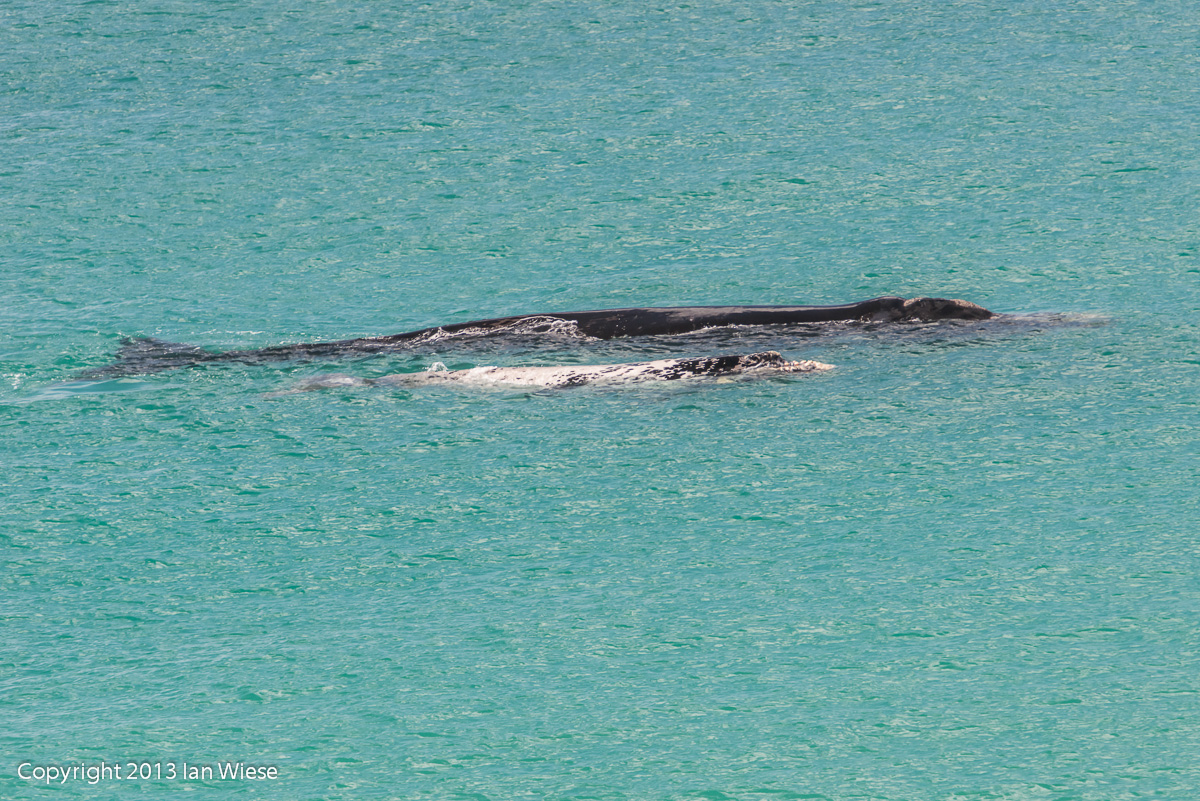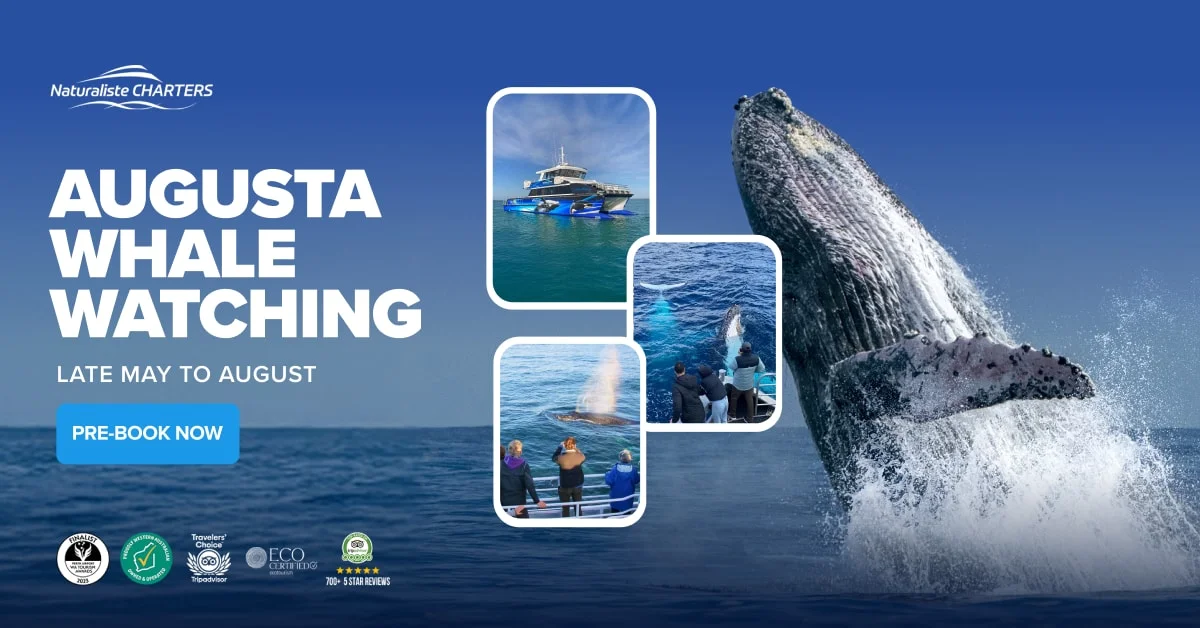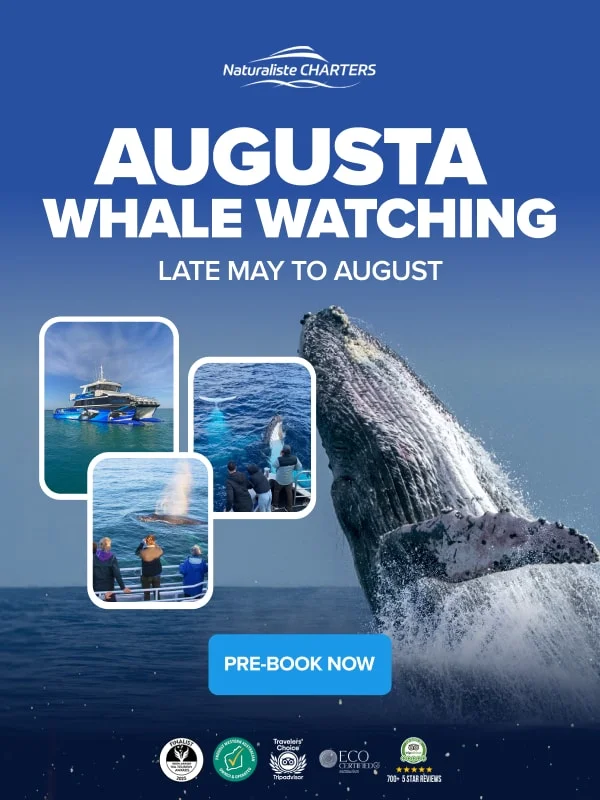Dave Riggs the Filmaker
For many of you, you may have heard of David Riggs or met Dave on board one of our Bremer Canyon Expeditions over the years. Dave is a film maker and a well known advocate for the Bremer Canyon. Dave was one of the key personnel involved in establishing the Bremer Canyon Killer Whale (Orca) Expeditions alongside Naturaliste Charters business owner Paul Cross. To learn some of the history on how these world class expeditions began read the below.
Research Expedition
Dave’s first trip out to the area we now know as the ‘hotspot’ was in 2006 when he was contracted to act as a wildlife observer onboard a Japanese southern bluefin tuna research expedition.The expeditions were conducted each summer and covered over 1000 nautical miles of ocean between Albany and Esperance. The personnel onboard the expedition consisted of 3 Japanese scientists, a skipper and Dave. Most of the journey saw them traversing miles of ocean without Dave seeing more than occasional flocks of flesh footed shearwater, yellow nose albatross, small pods of common dolphin and schools of 1 year old bluefin tuna which tended to congregate on inshore reefs and the edge of the continental shelf.
Each year a number of excursions were made over the edge of the continental shelf adjacent to Albany, Cheynes Beach and Bremer Bay. These excursions were pre-planned and rarely was the ‘transect line’ broken. One of these transects saw the team pass close by the killer whale hotspot offshore Bremer Bay. It was here that Dave began noticing more life than he was observing in any other part of ocean they were traversing. Killer whales were occasionally seen as they passed by. But it was the strange smell permeating the area that really caught his attention. We now know that smell is from freshly killed beaked whales.
There’s Something Special
Dave Riggs was onboard the bluefin tuna survey each summer between 2005-2012. Over time, he became convinced there was something special about the place we now regularly see the Bremer Bay killer whales. In early 2010 the area offshore Albany to Esperance was seismically surveyed for oil and gas over a period of 6 weeks. Dave managed to source a document from the proponent. It contained not only information on a possible commercial quantity of oil and gas. But also all the sightings of marine life observed during their survey.
The sightings of marine life made by the oil and gas explorers further fuelled his suspicions of a ‘hotspot’. They had also documented more life in one particular area than they observed elsewhere. The oil and gas observations were conducted by an independent company brought onboard from the UK. Now that the explorers had confirmed the likelihood of a commercial quantity of oil and gas in their tenement. Their next move was to conduct a more extensive 3d seismic survey to further refine their understanding of the subsea geology. They also planned to sink an exploratory well in close proximity to the apparent aggregation of marine life. (At this stage there was still no certainty of a concentration of marine life)
Dave Riggs Sees the Potential
Understandably Dave was concerned. There was no effort being given to research the apparent ‘hotspot’ prior to high powered seismic or the establishment of a well. It truly seemed as though this amazing place would be extinguished before it was even recognised as existing. Rewind to September 2003 and the now infamous sperm whale stranding at ‘Hebs Beach’. Dave and his wife had travelled from Esperance to film the reported stranding of 9 pregnant sperm whales. They were working as contractors for two CSIRO scientists spearheading Australia’s first large scale white shark tagging project.
Shark Tagging Expeditions
Dave and Jennene were employed to document each tagging expedition for CSIRO’s animal ethics and had been doing so since 2000. A number of sharks were tagging with both pop off archival and satellite tags during their week long expedition to the stranding. One of these sharks, a 3.2 metre female known as ‘shark Alpha’ was seemingly consumed by a larger more aggressive predator. This was in close proximity to the (at the time unknown) killer whale ‘hotspot’.
This unprecedented event wasn’t publicly reported and became a point of fascination to Dave. Fast forward to 2011 and Dave, as a final ditch effort to highlight the potential marine life aggregation before drilling could take hold, wrote a proposal for a documentary to ABC TV.
Dave Riggs Proposes a Documentary
The thrust of the film was shark Alpha and what marine creature could have been responsible for her demise. Possible perpetrators included killer whales, sperm whales, giant squid and white sharks.
ABC funded Dave’s filming expedition and he and his crew headed for Bremer onboard their filming vessel in late January 2013. This vessel was later acquired by Naturaliste Charters and is now the pride of their fleet… ‘Alison Maree’. The journey from Dave’s hometown of Esperance to Bremer was conducted at night. The pretty awful conditions and a strong southerly wind whipping up 3 metre swells which saw the team unable to rest for the entire journey.
Dawn saw them some 30NM east of the hotspot. The vessel was slowed and all eyes were on the water for life, specifically Bremer Bay killer whales.
The next 3 hours observation yielded nothing. The entire crew were sceptical of Dave’s suggestion there was a hotspot somewhere ahead. Most went downstairs to the relative comfort of the saloon where they attempted to sleep. At one point a scientist mentioned to Dave it was highly unlikely we would find his fabled hotspot of marine life. There’s no way it could have gone undiscovered until now. Beginning to doubt himself, he remained in the wheelhouse peering into the rough lifeless ocean. Desperately searching for a sign of anything! Maybe there wasn’t a hotspot at all?
The Ocean Erupted
Then it happened, 500 metres from the ‘hotspot’ the ocean erupted into life. Dozens of Bremer Bay killer whales materialised out of thin air and it was on! Non believers were instantly on the deck and gazing in awe at the spectacle. Dave reckons at that moment he felt his heart rate drop from 120 to 60 in a matter of seconds!
For the next 3 weeks the film crew documented consistent killer whale activity at the hotspot. It was finally confirmed to exist! Dave had been documenting whatever he saw during the tuna survey. Upon comparing his killer whale images with those taken during the filming expedition it became clear that the same animals were visiting the location year after year. The killer whale identification catalogue we have today was started in these early years of opportunistic observations. It has now been developed to a point where we know there are at least 200 individuals frequenting the site.
The Search for the Oceans Super Predator
Dave’s film was released on ABC on the 3rd November 2013, it was entitled ‘The Search for the Oceans Super Predator’. It was then screened in mid 2014 in North America on Smithsonian. From here re-versions were made and it ran in countries all over the world. Everyone wanted to know ‘What ate the Shark?’
Immediately after the initial ABC screening, Dave started fielding a stream of inquiries from people wanting to visit the killer whale hotspot for themselves. At this point he had no way of accommodating them as he didn’t have a suitable charter boat. One of his friends who happened to watch his film decided to help out and loaned him his 20 metre ex-fisheries patrol boat.
Crowdfunding Campaign
Now with a means of getting out to the newly discovered killer whale hotspot. He launched a crowdfunding campaign that he hoped would fund his 2014 expedition, this was in late December. The campaign was successful and he and a small team of scientists began visiting the Bremer Bay killer whales in late January 2014. On the 25th February Naturaliste Charters owner Paul Cross came out for the day. He witnessed the first ever beaked whale predation documented in Australian waters. Paul was obviously ‘blown away’ by what he saw.
Paul reached out to Dave to see if he was interested in joining forces. Dave as a filmmaker and Naturaliste as expedition operator. At the same time Paul was in touch, Discovery channel in the US had watched Dave’s film and wanted to make one of their own. All of a sudden 2015 was looking huge. Dave needed two big boats. Paul had 2 so Dave and Paul teamed up to run expeditions that could accommodate both passengers and film crews.
Killer Whales in the Spotlight
With a spotlight suddenly thrust on the Bremer Bay killer whales, the oil and gas proponent coincidentally relinquished their tenement. There was now an opportunity to try for protection of the site. Dave Riggs got in contact with Federal MP Rick Wilson via his science advisor Lesley Arnott. Together they began highlighting the location to the environment minister. It took several years of persistence but finally a portion of the ‘hotspot’ received a degree of protection. Specifically protection from future oil and gas exploration.
There is a whole lot more to the discovery of Bremer’s incredible killer whale hotspot, this is just the tip of the iceberg. Anyone wanting to know more can sign up to Dave’s webpage .. riggsaustralia.com and get it all from the horse’s mouth (so to speak).
Naturaliste Charters is to this day conducting Bremer Canyon Killer Whale Expeditions and all day tour out to the incredible Bremer ‘Hotspot’ on a daily basis during the December – April season. With their 96% successful sighting of the killer whale expeditions, you can tick off a huge bucket list item. Just visit their website at Naturaliste Charters Bookings.

